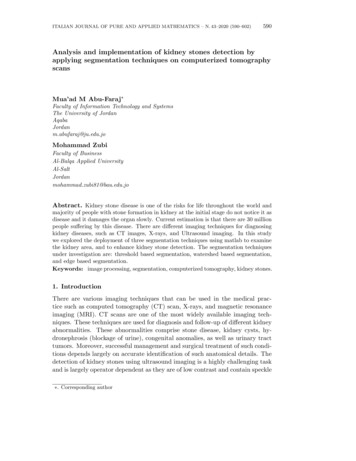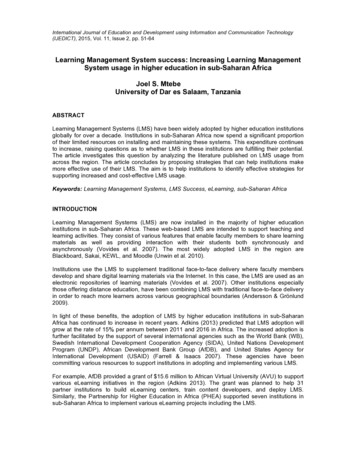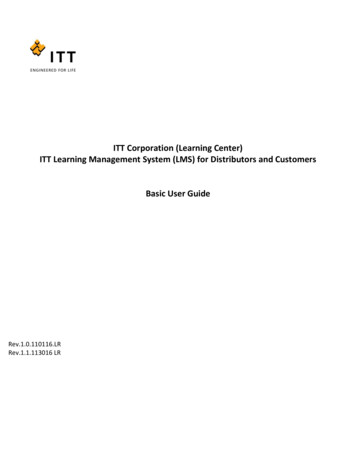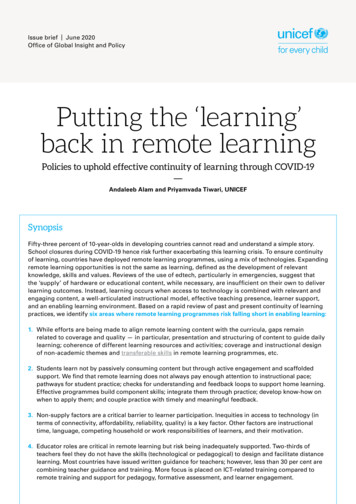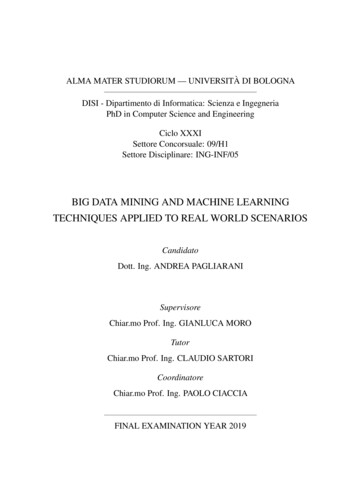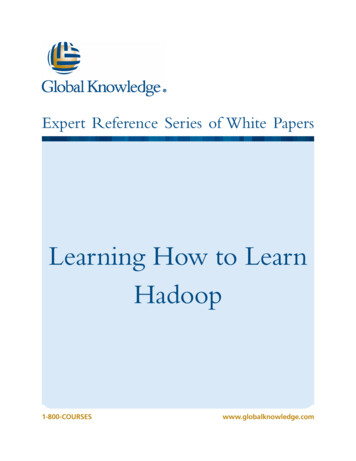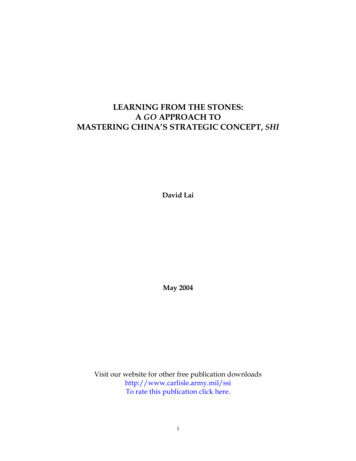
Transcription
LEARNING FROM THE STONES:A GO APPROACH TOMASTERING CHINA’S STRATEGIC CONCEPT, SHIDavid LaiMay 2004Visit our website for other free publication downloadshttp://www.carlisle.army.mil/ssiTo rate this publication click here.i
*****The author sincerely thanks Eric E. Fox, Lt Colonel USAF, for coining the titleof this study—Learning from the Stones.*****The views expressed in this report are those of the author and do notnecessarily reflect the official policy or position of the Department of the AirForce, the Department of the Army, the Department of Defense, or the U.S.Government. This report is cleared for public release; distribution is unlimited.*****Comments pertaining to this report are invited and should be forwarded to:Director, Strategic Studies Institute, U.S. Army War College, 122 Forbes Ave,Carlisle, PA 17013-5244. Copies of this report may be obtained from thePublications Office by calling (717) 245-4133, FAX (717) 245-3820, or by e-mail atRita.Rummel@carlisle.army.mil*****All Strategic Studies Institute (SSI) monographs are available on the SSIHomepage for electronic dissemination. SSI‟s Homepage address is: http://www.carlisle.army.mil/ssi/*****The Strategic Studies Institute publishes a monthly e-mail newsletter toupdate the national security community on the research of our analysts, recentand forthcoming publications, and upcoming conferences sponsored by theInstitute. Each newsletter also provides a strategic commentary by one of ourresearch analysts. If you are interested in receiving this newsletter, please let usknow by e-mail at outreach@carlisle.army.mil or by calling (717) 245-3133.ISBN 1-58487-158-Xii
FOREWORDMost of the ideas that form of the foundation of American defensepolicy and military strategy today were once new and untested conceptsat the far edge of strategic thought. It took thinkers of vision and creativityto give them life and refine them to the point they could be adopted by thedefense community and used for strategy and force development. This isa never ending process: new strategic concepts constantly emerge, somefade away, a few pass the tests of suitability, feasibility, and acceptabilityand make it into the mainstream.To help with this process of identifying those new and untestedstrategic concepts that merit further examination, the Strategic StudiesInstitute is publishing a special series called “Advancing StrategicThought.” This provides a venue--a safe haven--for creative, innovative,and experimental thinking about national security policy and militarystrategy.The following study by David Lai is the inaugural publication in theAdvancing Strategic Thought Series. In it, Dr. Lai uses the ancient game ofGo as a metaphor for the Chinese approach to strategy. He shows that thisis very different than the linear method that underlies American strategy.By better understanding Go, Lai argues, American strategists could betterunderstand Chinese strategy.The Strategic Studies Institute is pleased to officer this unique andcreative analysis as part of the Advancing Strategic Thought Series.DOUGLAS C. LOVELACE, JR.DirectorStrategic Studies Instituteiii
BIOGRAPHICAL SKETCH OF THE AUTHORDAVID LAI is on the faculty of the U.S. Air War College. He earned hisPh.D. in Political Science from the University of Colorado in 1997. Dr.Lai‟s teaching and research interests are in international relations theory,war and peace studies, comparative foreign policy, Asian security affairs,and Chinese politics. He has published widely in his teaching andresearch subject areas and is currently writing on issues related to theChina-Taiwan question, U.S.-Asian relations, and Chinese strategicthinking.iv
SUMMARYMost U.S. political and military leaders are aware of the difference instrategic thinking and international behavior between the United Statesand China. Many have also studied Sun Tzu‟s Art of War and can recitethe Chinese master strategist‟s famous saying: “Know the enemy andknow yourself, in a hundred battles you will never be in peril.” However,few really understand the essence of the difference.The author introduces a new approach to learning about the differentways of strategic thinking and interaction in Chinese culture. It is throughlearning the Chinese board game called go. This game is a living reflectionof Chinese philosophy, culture, strategic thinking, warfare, military tactics,and diplomatic bargaining. The author also sheds light on the remarkableconnection between go and the strategic concepts in Sun Tzu‟s Art of War.A modest claim is made in this writing that a little knowledge of gowill take U.S. leaders a long way in understanding the essence of theChinese way of war and diplomacy.v
LEARNING FROM THE STONES:A GO APPROACH TO MASTERING CHINA’SSTRATEGIC CONCEPT, SHIIn its July 2002 report to Congress, the China Security ReviewCommission states, “Chinese strategic thinking and military planningdiffer markedly from our own, underscoring the need to study suchdifferences more carefully.” The report also warns “the possibilities ofmiscalculation, miscommunication, and misunderstanding are high, giventhe substantial differences in each country‟s thinking and planning, andrequire far more attention from U.S. policymakers and the Congress.”1Coincidentally the Department of Defense (DoD) also released itsannual report on Chinese military power in July 2002. The Pentagonreport calls attention to several knowledge gaps in the U.S. understandingof China‟s strategic thinking. Particularly, it mentions a concept, shi,putatively a strategy China uses to exploit the “strategic configuration ofpower” to its advantage and maximize its ability to preserve its nationalindependence and develop its comprehensive national power. ThePentagon report notes:There is no Western equivalent to the concept of “shi.” Chineselinguists explain it as “the alignment of forces,” the “propensity ofthings,” or the “potential born of disposition,” that only a skilledstrategist can exploit to ensure victory over a superior force.Similarly, only a sophisticated assessment by an adversary canrecognize the potential exploitation of “shi.”2Indeed, shi is such an important concept that Sun Tzu, the Chinesegrand master of military strategy, uses it for the title of a chapter in his Artof War, the world‟s oldest military treasure.3 In this chapter, Sun Tzu hasdiscussed four key aspects of shi. First, it is the idea of qi and zheng. Zhengis the regular way of doing things, or in military terms, the regular orderof battle. A commander deploys troops in regular (zheng) ways. However,the commander must mobilize his troops to engage the enemy inextraordinary (qi) ways. Zheng is, in essence, a given. It is open knowledgeto friends and foes. Yet qi is a variable and its variation inexhaustible. Thevi
second aspect of shi is about creating an overwhelming force withirresistible unleashing power (a grindstone against eggs, and the strike ofa hawk at its prey). The third aspect of shi is about developing a favorablesituation with great potential to achieve the political objectives. Finally, shiis about taking and maintaining the initiative. As Sun Tzu puts it, “thoseskilled at making the enemy move do so by creating a situation to whichhe must conform.”These aspects of shi are also found in Sun Tzu‟s discussion of other keyconcepts in the Art of War such as deception, stratagem, intelligence,deterrence, and so on. Sun Tzu maintains that these key concepts are vitalto victory; one must study and master them during peacetime; and it willbe too late to consult experts (books or specialists) when grave occasionsarise. In essence, Sun Tzu suggests that national leaders, political andmilitary alike, make strategic thinking and employment of tactical skillspart of their second nature.How does one nurture this second nature? Learning and practice arethe ways to go. The author offers a new approach to learn and practiceSun Tzu‟s strategic and operational ideas—through learning the game ofgo.4 Go is of Chinese origin and is the world‟s oldest board game, yet stillremarkably popular and viable. It is probably the most sophisticated gameas well. This game bears striking resemblance to the Chinese way of warand diplomacy. Its concepts and tactics are living reflections of Chinesephilosophy, strategic thinking, stratagems, and tactical interactions. Thisgame, in turn, influences the way Chinese think and act. This work bringsto light another important feature of this game—its connection to theChinese military classics. The four key aspects of shi in Sun Tzu‟s Art ofWar are also guiding principles of go.In the American culture, many liken the American way of war anddiplomacy to the games of chess (power-based fight), poker (bluffing andrisk-taking), boxing (force on force), and American football (in many ways,resembles the American war machine). The game of go is different fromchess, poker, boxing, and American football in many key aspects. Whilethe American way of war has its strengths, a little knowledge andexperience of the game of go will be a valuable addition to the Americanpolitical and military wisdom; and it will take U.S. political and militaryleaders a long way in understanding the Chinese way of war anddiplomacy.2
CHINESE WAY OF WAR AND DIPLOMACYA popular saying in the Chinese diplomatic and defense communitiesis about the Chinese way of war and diplomacy and its difference to thatof the West: Chinese place heavy emphasis on strategy and stratagemswhereas the West relies more on overwhelming force and advancedcapability. By many accounts, this is an accurate characterization. TheChinese even go so far to call China the birthplace of stratagems. After all,China has the world‟s first comprehensive military classic, the Art of War,and the largest number of ancient military writings. While these militarywritings address many aspects of military affairs, they all emphasizestrategy and stratagems.Among these military classics, Sun Tzu‟s Art of War is undoubtedly theepitome of the Chinese way of war and diplomacy. In this work, Sun Tzuexpounds on many key thoughts on warfare and the conduct of war.Three of them are of great significance: a broad conception of the art ofwar, an emphasis on strategy and stratagem, and a dialectic view on theway to fight.In the Art of War, Sun Tzu treats the political, diplomatic, and logisticalpreparation for war, war fighting, and the handling of the aftermath ofwar as integral parts of the art of war. In this broad framework, the art ofwar is, in essence, the process of diplomacy; war fighting is onlydiplomacy by other means.Sun Tzu‟s emphasis on strategy and stratagems follows from hisprudent view on war—it is a vital matter of the state, survival or ruin. SunTzu is especially cautious on the cost of war—while waging war canadvance a state‟s interest, it can bring a state disaster as well. As an oldChinese saying goes, when you kill 10,000 enemy soldiers, you are likelyto lose 3,000 lives as well. Hence, as Sun Tzu puts it, a farsighted rulerthinks about warfare carefully; a good commander exploits the art of warfully; if there is no benefit, advantage, or real danger, a state must not setthe war machine in motion. “Thus those unable to understand the dangersinherent in employing troops are equally unable to understand theadvantageous ways of doing so.” Preserving the vital interest of a statewithout the use of force therefore is the first principle in Sun Tzu‟s Art ofWar. To achieve this goal, Sun Tzu places great emphasis on strategy andstratagems. Thus in the Art of War, Sun Tzu treats warfare, from itspreparation to execution and termination as first and foremost a contest of3
wisdom. Use of force is secondary. From Sun Tzu‟s perspective, a winningside uses force to consolidate assured victory, whereas a losing side usesforce only to make a gamble or a desperate attempt for survival, neither ofwhich is a good strategy of war.Adding complexity to the battle of wits is Sun Tzu‟s remarkablysophisticated dialectic view on nature, warfare, strategy, and stratagem.The Art of War is full of observations about the dialectic nature of strategicconcepts such as weak vs. strong, more vs. few, defense vs. offense,regular vs. extraordinary (qi and zheng), direct vs. indirect, division vs.unity, laboring vs. resting, advance vs. retreat, far vs. near, and therelativity and mutual transformation of these strategic situations. SunTzu‟s teaching is to exploit the opposite of the enemy‟s strategy and action.Therefore, when capable, feign incapacity; when active, inactivity. Whennear, make it appear that you are far away; when far away, that you arenear. Offer the enemy a bait to lure him; feign disorder and strike him.When he concentrates, prepare against him; where he is strong, avoidhim. Anger his general and confuse him. Pretend inferiority andencourage his arrogance. Keep him under stress and wear him down.When he is united, divide him. Attack when he is unprepared; sally outwhen he does not expect you.Sun Tzu‟s dialectic views are in complete harmony with thephilosophies of Yin and Yang and Daoism. Sun Tzu and Lao Tzu, theintellect of the Daoist School of thought, particularly liken the character ofthe military and the way of war and diplomacy to the flow of water.Water is perhaps the best example of the dialectic nature of things. It hasno constant shape. There is nothing softer and weaker than water, yetnothing is more penetrating and capable of attacking the hard and strong.The flow of water, carrying with it the shi, can wash away anythingstanding in its way.With over 2,000 years of influence from Sun Tzu‟s teaching, along withthe influence of other significant philosophical and military writings, theChinese are particularly comfortable with viewing war and diplomacy incomprehensive and dialectic ways and acting accordingly. Indeed, manyof these observations have become proverbial components of the Chineseway of war and diplomacy. The most notable ones are bing yi zha li (war isbased on deception), shang-bing fa-mou (supreme importance in war is toattack the enemy‟s strategy), qi-zheng xiang-sheng (mutual reproduction of4
regular and extraordinary forces and tactics), chu-qi zhi-sheng (win throughunexpected moves), yin-di zhi-sheng (gain victory by varying one‟s strategyand tactics according to the enemy‟s situation), yi-rou ke-gang (use the softand gentle to overcome the hard and strong), bishi ji-xu (stay clear of theenemy‟s main force and strike at his weak point), yi-yu wei-zhi (to makethe devious route the most direct), hou-fa zhi-ren (fight back and gain theupper hand only after the enemy has initiated fighting), sheng-dong ji-xi(make a feint to the east but attack in the west), and so on. All of thesespecial Chinese four-character proverbs are strategic and dialectic innature. All bear some character of flowing water.This Chinese way of war and diplomacy is in striking difference to theWestern way of war from ancient Greece to the United States today. In theWestern tradition, there is a heavy emphasis on the use of force; the art ofwar is largely limited to the battlefields; and the way to fight is force onforce. As one observer puts it, “the Greeks developed what has beencalled the Western way of war―a collision of soldiers on an open plain ina magnificent display of courage, skill, physical prowess, honor, and fairplay, and a concomitant repugnance for decoy, ambush, sneak attacks,and the involvement of noncombatants.” With respect to stratagem,Alexander the Great said, when he was advised to launch a surprise nightattack against the Persians:The policy which you are suggesting is one of bandits and thieves, theonly purpose of which is deception. I cannot allow my glory always to bediminished by Darius‟ absence, or by narrow terrain, or by tricks of night.I am resolved to attack openly and by daylight. I choose to regret mygood fortune rather than be ashamed of my victory.5The Western way of war finds its comprehensive theoreticalexpressions in the Western military classics of Carl von Clausewitz andBaron Antoine-Henri de Jomini. It has also made its impressive footprintsin battlefields throughout the ages and across the globe. Today, theAmerican way of war has become a more popular term for the Westernway of war. As described by military historian Russell F. Weigley, theAmerican way of war uses massive power, excels in advanced technology,and pursues total victory. 6 Backed by U.S. mighty military power, theAmerican way of war has put on impressive shows in wars in Iraq, theformer Yugoslavia, and Afghanistan. In the most recent war on Iraq, the2003 Operation IRAQI FREEDOM, the United States used a “leaner force”5
(smaller in number as compared to the massive buildup against Iraq in1991), yet faster in maneuver, armed with sharper precision firepower,and advanced with surprise attacks. Some observers call this revolution inthe Western way of war.7 However, one can see that the fundamentals ofthe Western way of war remain unaltered. The revolution has only madeit more powerful.Comparing the Chinese and Western ways of war and diplomacy, onecannot but wonder which one is better. The Chinese believe their strategictraditions are superior to those of the West, both ethically and effectively.Chinese strategists tend to stress the significance of culture and end upstereotyping U.S. and Western ways of war.8 While a good answer to thisquestion is difficult to qualify, one has to see that the West has dominatedworld politics with its superior comprehensive power over severalcenturies. The Chinese are aware of this fact. They also understand thatwithout solid and credible capability, the play of strategy is empty. That iswhy the Chinese are so determined to develop China‟s comprehensivenational power.That said, one must see that while the Chinese are doing theirhomework (developing their capabilities), the West should spend sometime learning about Chinese strategic thought and stratagem skills. AsSun Tzu puts it, “know your opponent and know yourself, in a hundredbattles you will never be in peril.”LESSONS FROM THE GAME OF GOIn many ways, the game of go resembles the Chinese way of war anddiplomacy. This game has its origin in China about 4,000 years ago and isthe oldest board game in the world. The original Chinese name of thisgame is called weiqi (pronounced wei ch‟i); literally, encircling territory, anessential component of a nation state. Two players compete for territories.The one who acquires more wins.The game board is conceived to be the earth (back in ancient times,people believed the earth was flat and square). The board is square,representing stability (See Figure 1). The four corners represent the fourseasons, indicating the cyclical change of time. The game pieces, the stones,are round, hence mobile. The spread of stones on the board reflectactivities on earth. The shape of the stone engagements on the board islike the flow of water, an echo in Sun Tzu‟s view that the positioning of6
troops be likened to water: “as water varies its flow according to the fall ofthe land, a military varies its method of gaining victory according to theenemy situations.” Sun Tzu also uses stones to describe military affairs:rolling boulders create shi.The two players take turns to place black and white stones on theintersections (but not the open squares) of a 19 x 19 line matrix, one pieceat a time. The black and white stones engage with one another in the game,exemplifying the concept of yin and yang and penetrating each other‟sterritories as the flow of water.Figure 1.The stones have equal physical power (there is no almighty queen orlittle pawn as in chess), resembling the relatively equal physical size ofindividuals. Yet the importance and potential of the stones in the game arebeyond imagination, resembling the boundless creativity of humanindividuals. Even a super computer today cannot map out theiralternatives. Of note here is that in 1997, the IBM super computer DeepBlue finally defeated the chess grand master Garry Kasparov. Yet at thecelebration ceremony, the designers of Deep Blue also admitted that theycould not write a program to beat even a mediocre go player, not any timesoon.7
The game of go starts with the game board completely open. Thisspecial design allows for creative strategic thinking and interaction. Bygame rule, the one who plays Black goes first. Once played, the stones stayin place unless captured and removed by the opposing player. The gamewill become more complicated as the two players put more stones on theboard (unlike chess, where the further the game goes, the fewer pieces onthe board, hence simpler).Figure 2.The basic objective of the game is to secure more space on the board(or more territory). The players do so by encircling more space on theboard. The competition for more territory thus leads to invasion,engagement, confrontation, and war fighting. Sun Tzu‟s thoughts and theessential features of the Chinese way of war are all played out in the game.As the game unfolds, it becomes a war with multiple campaigns andbattlefronts. Or in terms of international affairs, it is a competitionbetween two nations over multiple interest areas.Figure 2 shows the initial five moves of a game between two Chineseprofessional players.9 In the game of go, the first 50- some moves are called8
the opening-stage moves. At this point, players develop their strategicplans, adjusting constantly to the new situation created by the opponent‟scountermoves. Strategic moves, diplomatic posturing, and testing eachother‟s waters are the hallmarks of the opening of the game. These earlymoves set the stage for the entire game, affecting the battles andcampaigns 50 to a 100 moves later and throughout the game (long-termand calculated strategy is a key aspect of this game).Black 3 and 5 have created a firm command of the corner, securing a“theater” in the lower right side of the war plain. Working in concert withBlack 1 at the top, the three black stones make a large claim of “sphere ofinfluence” on the right side of the board.White must respond to Black‟s claim. But at this early stage with only afew stones on the board, it is difficult to locate the “center of gravity” or“decisive point” (in Clausewitz and Jomini‟s terms, respectively). SunTzu‟s teaching to attack your opponent‟s strategy comes into play. InFigure 3 we see that White immediately placed stone 6 on the board tocounter Black‟s posturing. White 6 instantly changed the strategic outlookon the board. The three white stones in turn have made a much largerclaim of sphere of influence on the left-hand side. Both players have triedto develop an advantageous situation that is consistent with Sun Tzu‟sthird aspect of shi.Black did not let White‟s claim stay long. Black 7 struck deep intoWhite‟s claimed sphere of influence. It went also as an attack on White‟sstrategy (Sun Tzu‟s teaching), interrupting White‟s strategic outlookinstantly (Figure 4).Black 7, however, is a very subtle move. It engages White 4 but doesnot pose a life-threatening situation to White. It is in White‟s claimedsphere of influence but keeps an arm‟s length from White 4. At its position,Black 7‟s strategic potentials are open to imagination. This is a move oflong-term and calculated strategic interest.9
Figure 3.Figure 4.10
Black 7 is a typical go-style engagement, one that serves to test White‟sintention (whether White wants to keep the corner or compete for thecenter). It is also characteristic of the Chinese calculated strategic thinkingand behavior. One Chinese act in the 1960s is a good example. During the1960s, China made much effort to solicit African support for its quest tobecome a member of the United Nations (UN) (African countries formed alarge voting block at the UN General Assembly). One of the Chineseefforts was to build sports stadiums in many African countries. Thisseemingly unconnected act went a long way to help China get the Africanvotes at the UN (China won the fight and became a UN member in 1971).The thought and play on Black 7, however, is rather uncharacteristic ofAmerican mindset and behavior. Generally, Americans are morestraightforward. When Americans take action, they expect immediatereturn. U.S. policy toward North Korea, for instance, emphasizesreciprocity. Because quick and desirable response from North Korea isdifficult to obtain, U.S. decision makers often feel frustrated and tend tosee their policy as a failure. South Korea, however, pursues a Sunshinepolicy toward the North. This policy takes its title from an Aesop fableabout “The Sun and the Wind.” 10 It counts on long-term and gradualefforts to promote change in North Korea. Americans, not surprisingly,have no patience for such a policy. South Korean leaders in the last severalyears have been calling on the United States to show more patience andunderstanding towards their Sunshine policy. Unfortunately, both are inshort supply on the American side.A play like Black 7, which promises no immediate and concreteresponse from White, is difficult for Americans to make. But this gameoffers Americans the opportunity to nurture such sensibilities.In Figure 5 we see that the two players have exchanged a few directlyengaged moves. These are standard moves in a situation like this (in SunTzu‟s terms, they are regular engagements, zheng moves; and in go, theyare, joseki).11
Figure 5.Consistent with the subtle thought on Black 7, these early engagementsare not for the kill, but a testing of the other‟s reaction and intention.White reinforced his hold on the corner. Black took an outward posturing.The two players exchanged messages: White went after tangible interest(territory) in the corner; Black created a shi to pursue interest in the center.This is also a “live and let live” play. Both are satisfied with theoutcome. There has been much writing in Japan about this kind ofengagement. The Japanese compare this engagement to the competitionfor market share between firms.11 In go, as well as in business, it is difficultto have all the gains and profits. Although there is a natural tendency forone to seek landslide victory, a player should guard against thistemptation and be prepared to settle with a win-win outcome. Overlyaggressive usually leads to disaster.Black troops 7, 9, and 13 have formed a creative stronghold. Thisgroup of three has room to make a secure base along the left-hand side,making this group invincible and able to expand into the center (a goodimplementation of Sun Tzu‟s strategy: you must first make yourself12
invincible and then wait for the enemy to show signs of vulnerability andlaunch an attack from your secured base).Black 11 took the initiative to engage White 2 on the upper left-handcorner. Now the reader should look at the overall situation as shown inFigure 5 (looking at the whole picture is a typical Chinese way ofassessment). Black‟s strategic design is clearly on the center and the rightside of the war plain. The four groups of Black stones stand in dynamicechoing positions. A promising strategic design is taking shape. Yet it isstill premature for Black to celebrate victory at this moment. Indeed,White is waiting for every turn to frustrate Black‟s strategy. The two whitestones 2 and 12 are already eyeing the open area in the center. White 6 atthe bottom occupies a critical strategic position. It keeps White‟s reach intothe center wide open. This is a critical countermeasure White made at theearly stage of the game against Black‟s strategic design. Its potential growsas the game unfolds.At this point, one can say that the two players score fairly in theiropening-stage strategic designs. Black has a secured corner on the lowerright-hand side. White‟s countermeasure is a similar sized corner on thelower left-hand side. White 2 and 12 hold part of the upper left-handcorner. Black 11 is waiting for the right moment to penetrate into thecorner. Therefore it is a shared claim on the upper left-hand side. On theupper right-hand corner, Black 1 occupies a key strategic position.However, there are wide-open areas on its two sides, making Black‟sclaims vulnerable to challenge from White. During go games, playersconstantly make this kind of assessment till the end.Figure 6 shows a well-matched engagement between the two players.White 14 has strengthened White 6‟s strategic claim at the bottom andreinforced White‟s determination to compete for the center (or to frustrateBlack‟s strategy for the center). At the upper right-hand side theater,White has successfully made an invasion deep into Black‟s claimed area.Black fought back and effectively separated the white troops into twounconnected groups, while securing its hold on the corner. This is aperfect example of divide and rule, another key feature of go. The twowhite groups have room to maneuver and secure a foothold for survivallocally. However, at this moment, they are still vulnerable to attacks fromBlack.13
Figure 6.Of note is another key feature in the game of go―the relativity ofoffense and defense. In Figure 6, while the three Black groups focus onattacking the two White groups, from the left, in the middle, and from theright, the three Black stones at the top (11, 17, and 27) are under a pincerattack from the White groups on their left and right. Who is attackingwhom? It is a matter of perspective.In Figure 7 we see the battle over the fate of the White groups at thetop turned bloody. The line of Black troops 21, 43, 45, 53, 49, 39, and 57threatens the survival of the White group. The battle hinges upon a fightover a ko at the intersection of M-14.Ko is a unique feature. There is no equivalent in other board games.Here is how it comes about and affects the course of the game. The lastmove on the board is Black‟s 57. This play removed a White stone fromthe int
Among these military classics, Sun Tzu‟s Art of War is undoubtedly the epitome of the Chinese way of war and diplomacy. In this work, Sun Tzu expounds on many key thoughts on warfare and the conduct of war. Three of them are of great significance: a broad conception of the art of war, a

